Art Tools of Liz Steel
Liz Steel: Thanks Parka for asking about my tools and gear - I am going to enjoy this!
I want to say at the start, that in recent years I have seen myself as primarily a sketcher who sketches for myself — not producing paintings to be hung on a wall. I want to record my life in my sketchbook as spontaneously as possible — so I work fast, very fast.
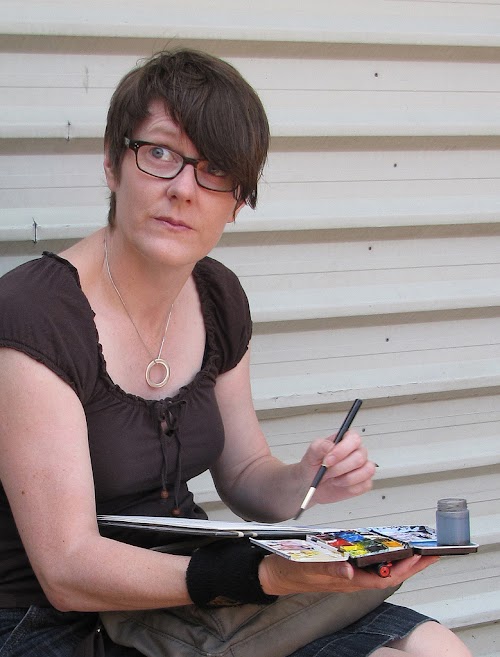
I take my gear with me everywhere so it must be light but as I often attempt sketches in crazy situations or within very limited time constraints, it must be flexible as well. There is always a tension between a compact kit and being ready to capture the moment quickly. My tools are always changing and evolving — growing and expanding till I realise I am carrying too much stuff and then I pull back to basics.
Qn: Can you talk about the drawing tools you have and use? I know you have a lot of Lamy fountain pens, waterbrush.
I am a bit of a fountain pen junkie — I have been using them since I was about 10 years old when my Dad gave me one of his old Parker pens and I fell in love with the flow of the ink on paper and how much neater my handwriting looked.
Through primary and secondary school, university and 20 years working as an architect I have used a fountain pen off and on. But in 2007 I bought my first Lamy and well that was it — I was hooked — fountain pens all the way now!
This photo makes me quite emotional since the first two pens from the left: Lamy Joy pens (Black and Red) have both been lost in the last 12 months. I now have a white version of the same pen (easier to see if I drop it in a cafe with black sofas!)
So what is the fuss about the Lamy and in particular the Joy? It is a joy to use (sorry about the pun!) for both writing and drawing, it is light in weight. I find the shape of the grip perfectly suits my hand but especially I LOVE the balance of the long tail.
The Joy is the calligraphy model but I replace the calligraphy nib with an EF normal nib.
For me the most important thing about a pen is how it feels in the hand. I do want to find an alternative with a nib that gives varying line thicknesses but with the amount of sketching I do, it is important that it feels right!
I then have a few extra Lamys with different inks or nibs. I like to use different coloured lines in my sketchbooks for variety, maps, notation etc. and although a coloured felt pen does the same job, I prefer using ink.
- Yellow Lamy safari containing my Noodler's Polar brown ink (hmm... They don’t do a brown safari!)
- Red Lamy Safari with Noodler's Cayenne
- Lamy Vista (clear safari) with Noodlers Polar Blue ink (love this!)
- Newer style black and silver Lamy Joy pen with a GOLD EF nib. The new style Joy is a fraction heavier than the old style... I prefer black and red or white Joys in my hand. This nib is lovely and has more flexibiliy than a standard nib but I am afraid to take it out on location (the nib cost 2 x the price of the pen)
- Pilot Parallel Pen in 1.8mm (I also have the 3.5mm size) Quite unpredictable to use ...it was an impulse buy thanks to the influence of Josu Maroto
- Noodlers Flex Pen with Lexington Grey ink... Never really warmed to this and it leaked on the plane once.
- Rotring Art Pen – this is one of the pens I used as a uni student and used this at work. It is even lighter than the Lamy Joy (old style) but for some reason I don’t like writing with it so would only use it when drawing. It seems to leak a lot so I have since abandoned it- sick of having ink marks on my fingers during client meetings!
- Fancy Lamy pen that I bought in the early days to hold my gold nib... But it is too heavy so has a calligraphy nib now.
Pentel pocket brush pen
BTW I also have a small collection of Hero and Sailor pens now and always carry a brush pen. The Pentel pocket brush pen has been a favourite for many years. I do like to have a pen that makes expressive lines — which I use as my 'fast tool'. The specific pen I have with me varies over time but their is always one in my kit.
Qn: What's that small cute pen below? Is it difficult to use?
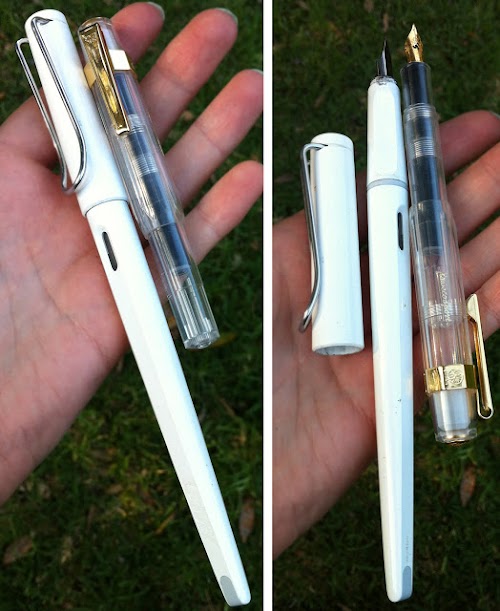
It is a Kaweco Sport and tiny with the lid on. Despite my love for long tail pens this one is surprisingly comfortable to hold. I don’t have a converter for it so currently am using it with water soluble ink. I really love it and it is SO cute!
Qn: What kind of ink do you use with your Lamy pens?
I use Noodler's bulletproof black as my standard ink. I haven't tried any alternatives as I have been very happy with it — and other options are not available in Australia (not that paying for overseas shipping has ever stopped me buying new stuff before!)
I know a lot of people have problems with this ink, but it works just fine for me and I often don’t wait long before putting watercolour over the top. The theories on why it runs for some people and not others include the amount of humidity in the air, the cotton content in the paper, whether you are drawing over graphite and how many stop and starts you have with your line work.
My personal theory is that it is important to keep the ink flowing. My Lamy Joy gets used everyday and I never have a problem... but the ink in pens that sit around do get very sticky.
Qn: Do you ever mix your own ink?
Never have tried that — tell me more... (no! don't tempt me)
Qn: You use a lot of watercolours. What was the first watercolour set you use?
In 2007 I discovered watercolour in a field kit and bought a Cotman kit without any knowledge that it was student grade (I have had no art training or background). It served me very well for about 18 months but then one morning, shortly after starting to share my work online, I woke up and just knew that I needed to buy artists quality from that moment onwards.

A WN Cotman box replaced with artist quality Daniel Smith & WN watercolour paints
Photo of my using it in Norway on a fast moving boat in a fjord in 2007...(sketching in crazy opportunities has always been a part of my work)
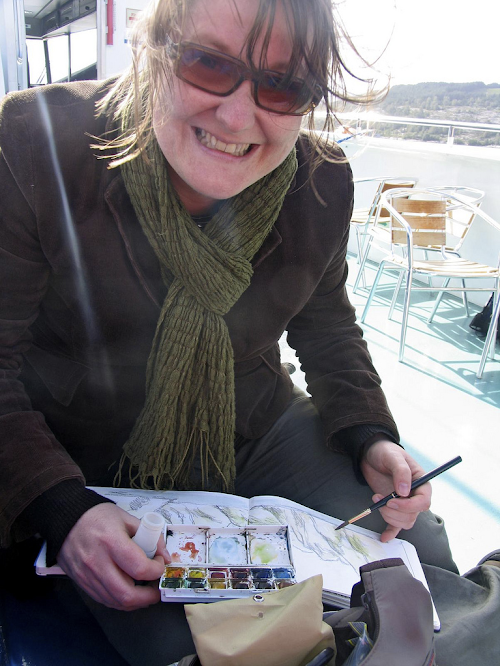
I am a firm believer in buying the best quality materials that you can afford… but I also don't think that people should rush out and buy expensive art materials if they will never end up using them.
Some of the Cotman kits have great lightweight compact boxes and this first box of mine is one of the best 12 pan kits out there. Cotman are not lightfast and have a lot less pigment — you can get strong colours with them but you have to work really hard. You also miss out on granulation which is my favourite aspect of watercolour. I would love to find a good affordable off the shelf kit for beginners!
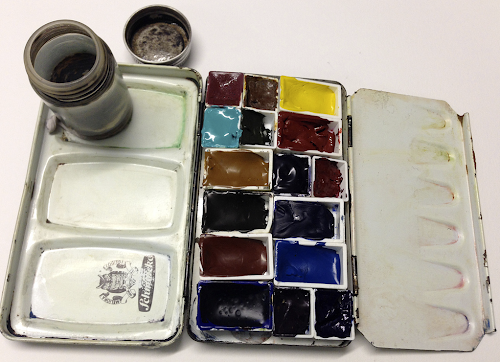
Qn: What's the watercolour box that you're using now? The schmincke one? Why? I notice there are no holders holding the pans down. How do they stick to the bottom of the box?
It is a Schmincke box and my favourite.
It is compact but with fold out mixing trays and I like the three divisions to the lid (one for brown/grey/ one for blue and one for green — I try to mix the same colours in the same places in my palette)
I drilled the metal clips off the tray and then fix the pans to it using blutack - that way I can load up the box with more paint!
Qn: What are the different brands of watercolour you use? Do you see any difference between them?
I mainly use Daniel Smith(DS) watercolours as they are the most vibrant colours I have tested.

However, I am not brand loyal but rather test out each pigment in different brands to find the one that works best for me. I also have one or two Schmincke and a few Winsor and Newton(WN) colours that I use.
Art supplies are VERY expensive in Australia and DS are cheaper than WN but WN are available in every art store, DS only in a few.
I personally do not think there is a great difference between pan and tube as a general blanket statement — there is a huge difference between pigments and brands. Some tube paint can dry rock hard and it can be more difficult to pick up colour from them than it is from pans which are designed to be re-wet numerous times. I think the problem is that many people who use pans often don't pre-wet them.
When I am travelling and using them everyday my pan paint have been very soft and vibrant... but as DS paints only come in tube paints that is what I am using these days.
Qn: What's your methodology towards choosing colours?
It is a combination of using a standard split primary with a few earth colours and then a few personal choices based around the colours that I use most. I think it is really important for people to build their palette around their own love of colour and typical subject matter.
As I work fast I do not want to be spending time mixing up a lot of colour and also I only use a very small water container... so I do include a few colours that I know will mix together well and easily.
I love granulating colours and putting down a few juicy washes and let the pigment interaction do the work. I also look for vibrant colours - the Australian light is bright and think my use of colour reflects that.

You can read more about it here (I could do a whole interview about colour!):
https://www.lizsteel.com/2013/04/my-basic-palette.html
Qn: I know you like to get different colours to try out. Don't you get confused when there are so many colours? Since each watercolour would have their own characteristic.
No I don't get confused as I know the characteristics of the colours that I have in my palette and I also know what work I want them to do.
I am always comparing new options with the existing 'friends' in my palette. I want those pigments in my palette to be as flexible as possible - so I am always on the look out for the best mixers.
Earlier in the year I had a session with local artist Jane Blundell who really knows her paints and we worked systematically through my palette looking at alternatives to what I had — this was an intensive masterclass...but normally I would just test one colour at a time. I am looking for vibrant mixes and a bit of pigment interaction.

Example of a colour mixing test
Qn: What other materials do you use besides watercolour? What's your perference? I saw some pencils
Lately I have been very interested in exploring water soluble pens and pencils.
Although I see myself as an 'ink girl' I was surprised earlier in the year that I enjoyed pencil as well — it seems to suit me better than ink when I am working fast. I hate anything that smudges but found that the Derwent sketching pencils (slightly water soluble) don't smudge as much as normal pencil.
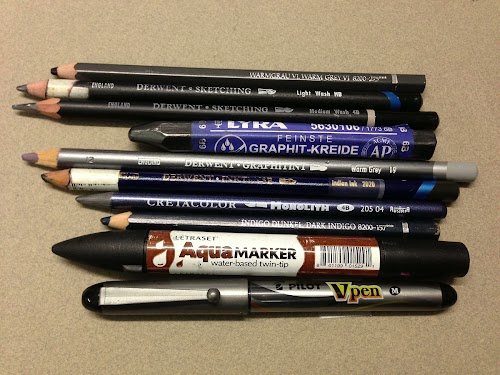
This photo shows some pens/pencils that I used when in Melbourne earlier in the year…and I am not sure how many I will keep in my kit long term.
Qn. Do you have any watercolour book to recommend? You mentioned Transparent Watercolour Wheel.
Transparent Watercolour Wheel was the first book I read that really got me focus on the different types of pigments and why I was getting mud due to mixing too many opaque pigments.
I also read a wonderful blog post by Roz Stendahl on how she choose colours in her palette (that post really should be the thinking process behind setting up a palette).
But my biggest reference is the Handprint site. I have spent hours and hours and hours poring through the pages there. Bruce McEvoy's basic palette rationale and then reading up on pigments.
But that is just about colour …
Qn: Name 8 watercolour colours that you must have.
What, only eight! I love colour so much that it is hard to limit myself but if I have to I would use a standard split primary approach and 2 earth colours
- DS Hansa yellow medium (beautiful vibrant yellow)
- DS Quin Gold (makes beautiful Australian greens)
- DS Transparent pyrrol orange (glorious orange red! love it!)
- DS Carmine (very versatile cool red)
- DS Ultramarine (a basic colour!)
- DS Cerulean Blue Chromium (better for Australian skies than the normal Cerulean)
- DS Monte Amiata Natural Sienna (an alternative to raw sienna but more transparent)
- DS Transparent Red Oxide (crazy reactive alternative to Burnt Sienna

Qn: For the adventurous, what colours would you recommend?
Well a few of my favourite colors not in the above list...
- WN Cobalt Turquoise Light
- DS raw umber (gorgeous cool brown)
- WN Potters Pink (granulating colour, mutes colours )
As for adventurous:
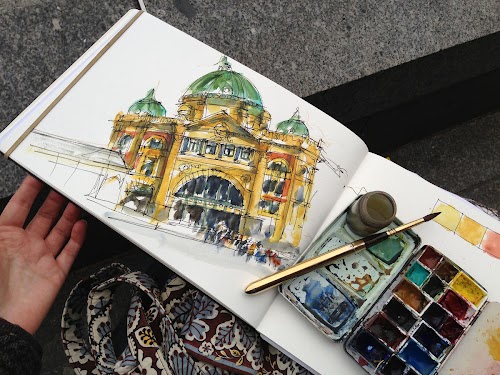
Qn: What are the brushes that you use?
I use an Escoda pocket sable brush #8 as my standard brush. I prefer the Da Vinca travel brushes but they are much more expensive. I love the softness, the hold and the springiness of the sable but unfortunately I wear out the points on these brushes and need a new one every 6 months.
I have tried using full pans and picking up the paint sideways on the brush but still the points wear out. So I am about to try the Escoda synthetic brushes for daily use and see if they last longer - or use they in combination with a sable. I also carry a 20mm flat brush (synthetic) and a rigger brush.
I want to try using a squirrel brush and am playing with a small synthetic dagger brush at the moment (always trying new things!)

Qn: I remembered you baked your tube colours once. Why did you do that? Did it damage the colours? Won't they just dry by themselves overnight or over a few days?
I have had problems with paint running all over the place after leaving to dry for 2 days so I like to allow for a full week before using them.
However I often don't have that amount of time. Through a friend I heard about a trick of putting them in the oven for 1 hour or so on 50C (just a bit hotter than a hot day!) I find it works very well and I always ventilate my oven well afterwards. But one time however I was careless about the temperature! (actually I have done it twice)
Qn: You're an architect, right? Are the tools you use for work different from leisure art? How are they different?
I have worked for an architect for nearly 20 years and have always done a lot of freehand drawing even in these days of computer domination. Some of the drawings and tools that I use are
- working drawings as I design. Done with ink pen on yellow trace (or butter paper) and I work very rapidly. The faster I draw the more design options I can explore.
- sketches of design concepts for preliminary meeting with clients. Ink or felt pen sketches over basic computer generated 3D models. Often coloured with markers (such as Copic or Admarker) and/or coloured pencils
- more polished sketches for submissions. Similar to above but a composite of freehand and computer images. Put together and enhanced in Photoshop
- lots of freehand details issued to builders during construction - drawn with felt pen on tracing paper.
So basically mainly dry media either on bond paper or trace paper. A degree of modification in photoshop is normally done. It needs to be flexible and easily modified.
This year I have been doing some architectural illustrations and they are ink and watercolour on watercolour paper.
Qn: I remembered you have this cloth band around your wrist. What's that?
A black sweat band for wiping my brush. To clean my brush and preserve my water as long as possible I dip and dab
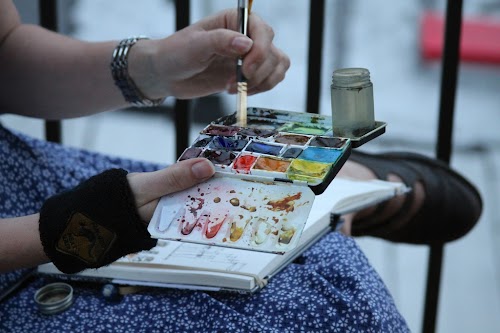
Qn: Which sketchbook do you use?
I like using the A4 watercolour moleskine in landscape format for my travel sketchbook — I like the paper — it suits my use of both ink, watercolour and watercolour pencils and the larger size gives me plenty of room for text, maps and collage of tickets and bits and pieces that I collect during the day. It is a little heavy to carry around as a daily sketchbook.

Qn: You're also trying out some Stillman & Birn sketchbooks. What do you think about them?
I love the Stillman and Birn sketchbooks.
I love that they have a bright white range - the Alpha and Beta paper.
The Beta paper is 270 gsm and beautiful to work with - but with only 52 pages in a sketchbook I go through it too quickly. I am using one right at the moment and nearly half filled it in a week. So for my daily sketchbook I love the Alpha paper (120pages, 150 gsm). It is not watercolour paper but can withstand a lot of water and mixed media and is perfect for my day to day scribbles and sketches.
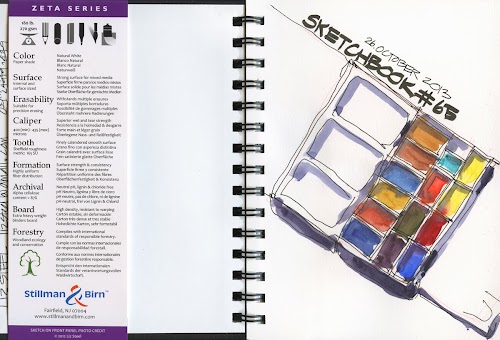
I have also recently tried the Zeta paper which is smooth and 270 gsm. It was great for ink work and would suit a lot of people's ink and wash. I like to get more interesting effects with my pigments and this paper didn't perform as well as the Beta or the Alpha.
Qn: I read in a post you were recommending some colour pencils for a class you were teaching. What are they?
I like to have a small collection of watercolour pencils with me for three reasons
- for quick sketches when I am on the run and standing up.
- for adding tone and colour when inside museums or churches etc where I can't use water.
- for adding texture. I mostly add watercolour over the top rather than just water.
These are Faber Castell and are by far my favourite brand of watercolour pencils. I also like some of the Derwent Inktense colours but sadly they are not lightfast. As you can see in this page what I 'should' have in my bag and what I end up with changes over time.
Qn: Have you ever bought something from the art shop, went back and tried it and dislike it?
Yes - occasionally! I have a few tubes of paints that I bought and didn't like. But sometimes I do find a use for them down the tract in my architectural illustration work. I still haven't found the perfect watercolour paper that suits my work.
Qn: Which scanner do you use? I noticed that even when scanning a spiral sketchbook, the scanned image appears to be perfectly sharp, even when there are areas of the paper not touching the surface of the scanner glass.
Epson V500 Photo scanner and have had it for a number of years and very happy. The spiral book you refer to was the Stillman and Birn zeta paper and at 270gsm it did sit nice and flat on the glass.
I always scan with a large heavy book over the top to flatten the sketchbook as much as possible. Ideally I scan with the spine of the book perpendicular to the direction of the scanning light so it doesn't pick up as much of the shadow in the spine. I then join using photo merge in Photoshop (don't always do this but it gives a much better result!)
I also pick up the white of the page with the magic wand and use the dodge tool to lighten it manually. I don't use levels to do this as it causes the light watercolour to blow out. (I have a 'how I scan' post on my to-do list!)

Qn: You've an interesting carrying bag? Tell us about it. What's your bare essentials sketching tools?
I am always looking for a handbag that is light (less than 500gsm) looks smart and has good front pockets for quick access to art tools. The secret of sketching especially when travelling is to be ready to go in a few seconds!
I am also developing the ‘perfect’ pen holder - this current prototype which I took to Barcelona in July is working well but I will make some adjustments in the next model. The idea is to have a pen holder that is compact, that allows every tool to be easily accessible when in my bag pocket and that can also be taken out and hung around my neck while sketching.
90% of the time I use my Lamy pen and watercolour and Escoda 8 brush but I also like a few watercolour pencils and 1 expressive line pen(a brush pen) as my 'fast tools'.
Qn: Last question, what media are you looking forward to try next? Why?
Well I really want to develop my watercolour skills primarily ... am I am looking for the perfect fountain pen with expressive lines. But in terms of something different...
I have a desire to do more studio work, work bigger on canvas (even abstract) and try oils (though I am not sure when I will find the time for that!)
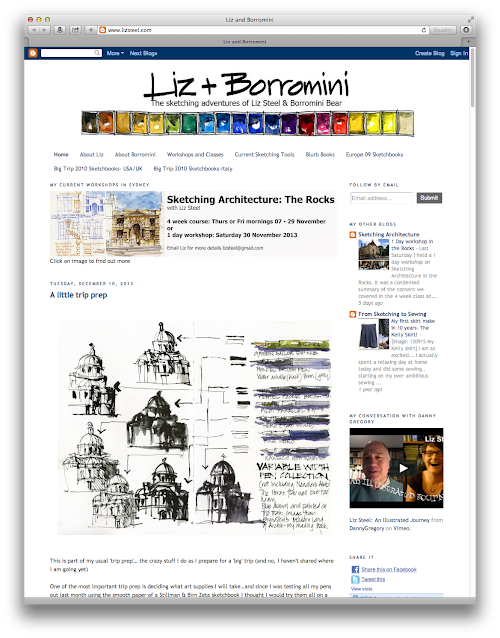
Parka: Special thanks to Liz Steel. I might have gotten carried away by asking so many questions. *laughs*. She writes even more on her blog.
Check out more of her artworks and adventures at https://www.lizsteel.com
Comments for Liz?
If you have comments for her, send them here: https://www.lizsteel.com/2013/12/my-art-tools.html
Items mentioned may be available at Amazon.com and Amazon.co.uk



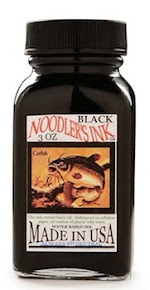




Comments
What a great interview.
What a great interview. Thank you for sharing all your this wonderful information! BTW, the "charcoal" Safari actually looks chocolate brown except for its black clip. Love Safaris myself. Cheers. :)